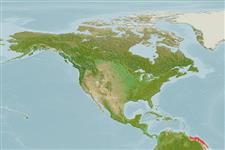Common names from other countries
Classification / Names / Names
Nomi Comuni | Sinonimi | Catalog of Fishes (gen., sp.) | ITIS | CoL | WoRMS
Environment: milieu / climate zone / depth range / distribution range
Ecologia
; distribuzione batimetrica 100 - 298 m (Ref. 271). Tropical; 14°N - 1°N, 58°W - 47°W (Ref. 4)
Western Atlantic.
Length at first maturity / Size / Peso / Age
Maturity: Lm ? range ? - ? cm Max length : 10.0 cm TL maschio/sesso non determinato; (Ref. 271)
It has lengths of 10 cm, maximum body length; 1.6 to 3.2 cm, carapace length (Ref. 4). Occurs at depths from 120 and 298 m, but there is a record from the littoral zone, and one from 4111 to 4122 m. The bottom is variously described as "sand and coral, "sandy calcarenite", and "smooth, consisting of brown mud" (Ref. 4).
Life cycle and mating behavior
Maturità | Riproduzione | Deposizione | Uova | Fecundity | Larve
Members of the order Decapoda are mostly gonochoric. Mating behavior: Precopulatory courtship ritual is common (through olfactory and tactile cues); usually indirect sperm transfer.
Holthuis, L.B. 1991. (Ref. 4)
IUCN Red List Status (Ref. 130435)
CITES status (Ref. 108899)
Not Evaluated
Not Evaluated
Human uses
Pesca: di nessun interesse
| FishSource |
Strumenti
Informazioni ulteriori
Age/Size
Accrescimento
Length-weight
Length-length
Morfologia
Larve
Abbondanza
Fonti Internet
Estimates based on models
Preferred temperature
(Ref.
115969): 13.6 - 18.8, mean 17.6 (based on 5 cells).
Vulnerability
Low vulnerability (10 of 100).
